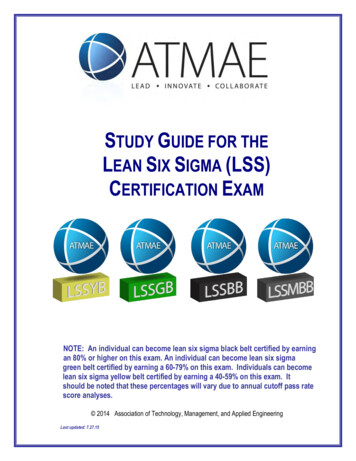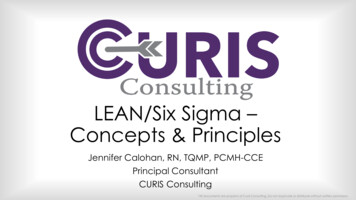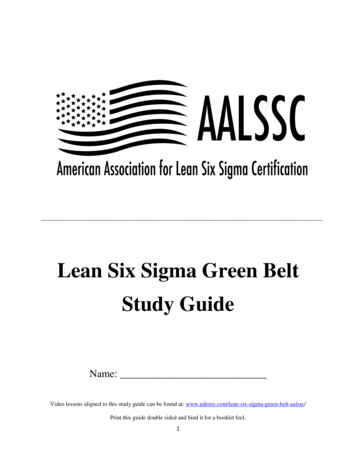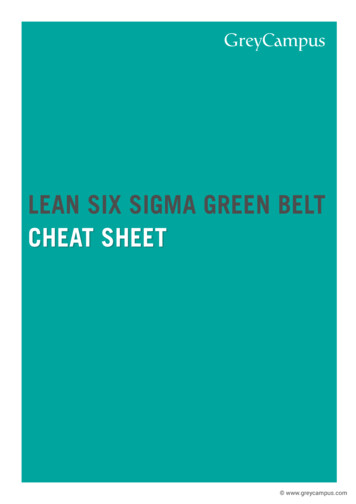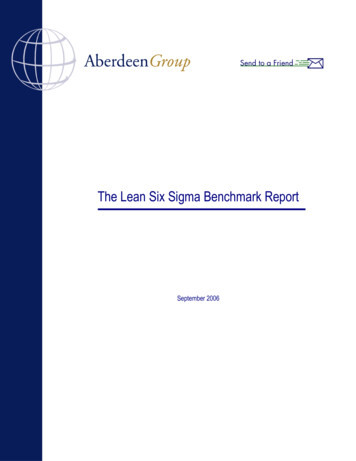
Transcription
The Lean Six Sigma Benchmark ReportSeptember 2006
The Lean Six Sigma Benchmark ReportExecutive SummarySix Sigma is an integrated, disciplined approach for reducing defects and producingmeasurable financial results. With its roots in statistical engineering, the Six Sigmaconcept embodies a data driven methodology focused on driving down processvariation so that no more than 3.4 defects are produced per million opportunities. Ithas long been associated with Lean Manufacturing. While Lean serves to eliminatewaste, Six Sigma reduces process variability in striving for perfection.Pressures to adopt Six Sigma are primarily driven by the need to improve operationalperformance in order to reduce costs and push financial results to the bottom line. Whileover 50% of respondents in Aberdeen’s Lean Six Sigma survey, as well as in past studies,indicated Six Sigma programs were implemented, we found less than 16% of “SixSigma” companies and less than 8% of all respondents are holding true to the rigorousprogram with the stringent quality goal, structured problem-solving approach, dedicatedtraining and prioritized projects that are the hallmark of the original Six Sigma philosophies.Key Business Value FindingsAdapting to the rigors of Six Sigma requiressignificant culture change for most companiesand many find it a challenge. Companies arefinding innovative ways to address this issuealong with the usual training programs and byattempting to introduce change gradually.However, training needs to reach the mind,heart and soul of a company and must be an ongoing effort.Not all challenges are cultural though. With itsstatistical engineering heritage, Six Sigmamethodologies are indeed dependent on data, sodata collection can present significant obstacles. Automated data collection and Information Technology (IT) solutions can play a keyrole in resolving these obstacles, yet findingsindicate insufficient use of automation and analytics to support Six Sigma activities.”The key to success is thecommitment of leadership.Saying it and doing it are 2separate things. It’s when theyput the funding in place that itreally takes hold.”-George Beres, OperationalExcellence Champion and SixSigma Black Belt, GlaxoSmithKlineImplications & AnalysisAs a result, enterprises are not achieving the anticipated goals of Six Sigma programs.Such factors leave Aberdeen to conservatively estimate that industry is missing out onbillions of dollars in potential savings, sales, and profits each year through ineffectiveapplication of Six Sigma tools and methodologies.All print and electronic rights are the property of Aberdeen Group 2006.Aberdeen Group i
The Lean Six Sigma Benchmark ReportRecommendations for ActionCompanies should evaluate their processes to ensure they effectively accomplish the following: Apply metrics of DPMO (Defects Per Million Opportunities) across all businessprocesses, not just manufactured products and parts. Identify and prioritize business impact projects according to anticipated savingsand improved throughput. Look first for low hanging fruit and act now for immediate benefit. Identify process and project owners who will accept ownership of and accountability for the improvement process. These process owners must uncover methodologies that lead to continuous improvement. This discovery process is an important aspect of developing ownership of improvement and driving to real results. Integrate data collection with analysis – connect (potentially disparate) sourcesof data and alarm usersAll print and electronic rights are the property of Aberdeen Group 2006.ii Aberdeen Group
The LeanSix Sigma Benchmark ReportTable of ContentsExecutive Summary . iKey Business Value Findings. iImplications & Analysis . iRecommendations for Action.iiChapter One: Issue at Hand.1What is Six Sigma?. 2It’s All About the Bottom Line . 3Has Six Sigma Penetrated the Enterprise? . 3Chapter Two: Key Business Value Findings .5Challenges and Responses. 6Benefits. 7Chapter Three: Implications & Analysis.9Process and Organization . 10Knowledge. 11Key Performance Indicators . 12Technology Usage . 14Technology Enablers . 15Process Planning: Process Mapping, Flowcharting, Value Stream Mapping. 15Statistical Analysis. 15Real-Time Performance Management . 16Project Management . 16Other Quality Management Tools. 16Chapter Four: Recommendations for Action . 18Laggard Steps to Success. 18Industry Norm Steps to Success . 19Best in Class Next Steps . 19Appendix A: Research Methodology . 20Appendix B: Related Aberdeen Research & Tools .1All print and electronic rights are the property of Aberdeen Group 2006.Aberdeen Group
The Lean Six Sigma Benchmark ReportFiguresFigure 1: Lean and Six Sigma Programs Co-exist .2Figure 2: Pressures Driving Quality Initiatives.3Figure 3: How Pervasive is Training Throughout the Organization?.4Figure 4: Strategic Actions in Response to Pressures .6Figure 5: Level of Certifications: Expected versus Actual.11Figure 6: Quality Metrics in Use .13Figure 7: Technology Adoption .14TablesTable 1: Six Sigma projects active across the organization .4Table 2: Quality Related Challenges and Responses .7Table 3: Six Sigma Competitive Framework .9Table 4: Sigma Value translated to number of defects .12Table 5: Quality Performance.13Table 6: PACE Framework .21Table 7: Relationship between PACE and Competitive Framework.22Table 8: Competitive Framework .22All print and electronic rights are the property of Aberdeen Group 2006.Aberdeen Group
The Lean Six Sigma Benchmark ReportKey TakeawaysChapter One:Issue at Hand Less than 16% of companies with Six Sigma initiatives are holding fast to the rigorousprograms of “true” Six Sigma On average participants with “true” Six Sigma produced 40% more savings than the general population including those with less rigorous programs. Focusing on quality metrics, including defect rates, leads the way to financial resultsSix Sigma is an integrated, disciplined approachfor reducing defects and producing measurablefinancial results. With its roots in statistical engineering, the Six Sigma concept embodies a data drivenmethodology focused on driving down process variation so that no more than 3.4 defects are produced permillion opportunities. It has long been associated withLean Manufacturing. While Lean serves to eliminatewaste, Six Sigma reduces process variability in striving for perfection.Lean Six Sigma has emerged most recently as organizations strive to meet the quality objectives defined bytheir customers. It combines the principles of Leanwith the best practices of Six Sigma. The result is amethodology that serves to improve processes, eliminate product or process defects and to reduce cycletimes and accelerate processes.Competitive Framework KeyThe Aberdeen CompetitiveFramework defines enterprises asfalling into one of the three following levels of practices and performance:Laggards (30%) —practices thatare significantly behind the average of the industryIndustry norm (50%) —practicesthat represent the average ornormBest in class (20%) —practicesthat are the best currently beingemployed and significantly superior to the industry normAs Lean Six Sigma has grown more ubiquitous over the past several years, has the concept been watered down? Has it become just another “quality system?” How tightly arethe two concepts linked? In a Lean Six Sigma survey conducted in late August and earlySeptember of 2006, Aberdeen found companies engaged in a variety of quality relatedinitiatives (see Figure 1).All print and electronic rights are the property of Aberdeen Group 2006.Aberdeen Group 1
The Lean Six Sigma Benchmark ReportFigure 1: Lean and Six Sigma Programs Co-exist52%Six Sigma56%Lean Manufacturing27%Operational Excellence programs31%TQM (Total Quality Management)14%Quality CirclesPursuing Shingo AwardPursuing Malcolm Baldridge Award0%80% Lean and20% SixSigma, 31%2%Relative emphasison Lean/Six Sigma50% Lean and50% SixSigma, 45%7%10% 20% 30% 40% 50% 60%20% Lean and80% SixSigma, 24%All respondentsSource: Aberdeen Group, September 2006A significant percentage of survey participants (52%)claim to be implementing Six Sigma and even more(56%) have embraced Lean Manufacturing. Thirtyseven percent of participants had both Lean and SixSigma initiatives while 20% had embraced Lean without Six Sigma (not shown). Of those with both, twothirds integrate the two programs, but the emphasis oneach varies (also in Figure 1).Aberdeen’s Definition of“True “ Six Sigma Have a formal SixSigma Program Adopted DMAIC methodology Require Black Belts toProduce Results forCertificationHowever, less than 16% of “Six Sigma” companies Require Business Imare holding true to the rigorous program with thepact Projects to be Valistringent quality goal, structured problem-solving apdated by Financeproach, dedicated training and prioritized projects thatare the hallmark of the original Six Sigma philosophies.As a result, the expected results are varied with “true” Six Sigma practitionersrivaling Best in Class in terms of both defect rates and financial outcomes. Thosewith less rigorous programs are falling far short of expected results. On averageparticipants with “true” Six Sigma produced 40% more savings than the general population including all with Six Sigma programs.What is Six Sigma?Literally, Six Sigma is a statistical measure that refers to the number of standard deviations away from the mean (or average) point in a bell shaped curve. In manufacturing, thenaturally occurring variations in processes will tend to fall under this bell shape, alsoknown as a normal distribution. Achieving Six Sigma quality translates to producing nomore than 3.4 defects per one million parts processed – not an easy accomplishment. Inmany industries 99% good quality is viewed as an exceptionally good measure, but inothers, such as medical devices and aerospace and defense, even a 1% defect rate meansAll print and electronic rights are the property of Aberdeen Group 2006.2 AberdeenGroup
The Lean Six Sigma Benchmark Reportpeople may die. In Six Sigma terms, Best in Class means 99.99966% good quality. ButSix Sigma is more than just about defect rates.It’s All About the Bottom LineFigure 2: Pressures Driving Quality Initiatives75%78%Improve operational performance to reduce cost72%68%Drive financial results to the bottom line48%49%Provide competitive advantage or differentiation29%32%Meet specific req'ts for quality defect ratesImprove delivery performance25%25%Improve product development and time to market24%22%Meet regulatory & compliance req’ts11%13%Meet specific requirements for quality certification10%12%0%20%Six SigmaAll40%60%80%100%Source: Aberdeen Group, September 2006Whether driving Six Sigma programs or other quality initiatives, it is clear that the keybusiness drivers revolve primarily around the bottom line, although in striving for competitive advantage, many also seek to impact the top line as well (see Figure 2). Whilequality metrics, including defect rates, may appear to take a back seat to producing financial results, most quality programs are built around the principle that assumes striving forzero defects can reduce absolute product costs by as much as 20 to 30%.Has Six Sigma Penetrated the Enterprise?If companies are indeed deploying Six Sigmaprograms, one would expect commitment,training and business improvement projects toinfiltrate throughout the organization. But thisisn’t happening with any great consistency(Figure 3). Granted, not all of these companiesare veterans at Six Sigma, but the majority ofour participants (61%) have had these programsin place for more than 2 years and 17% havehad them in place for more than 15 years.Another indication of the pervasiveness ofSix Sigma is the number of business impactprojects active across various functionalareas. While a third sit squarely in”We went after the best. We tookplant managers and individualswho managed quality across theNorth American continent. Theybecame our Black Belts. It takestime, but after 2 years we had abreakthrough.”-Jonathan Squire, HexionSpecialty Chemicals, IncAll print and electronic rights are the property of Aberdeen Group 2006.Aberdeen Group 3
The Lean Six Sigma Benchmark Reportmanufacturing, we did find that in most companies Six Sigma projects were active acrossthe entire organization (see Table 1), indicating that companies do recognize the potentialfor business process improvement outside of manufacturing, but have not yet thoroughlyentrenched Six Sigma in the culture across the enterprise.Figure 3: How Pervasive is Training Throughout the Organization?21%16%48%Executive/Senior 0%22%20% 30% 25%7% 6%23%60%Design40% 50% 60%25%-50%11%10%15%7%70% 80%50%-75%8%8% 5%18%64%Customer Service/Order Mgt7%11%14%70%After Market Service17%12%66%Procurement10% 7%13%64%Supply Chain/Logistics15%90% 100%75%-100%Source: Aberdeen Group, September 2006Table 1: Six Sigma projects active across the organizationBusiness Impact ProjectsManufacturingDesignCustomer Service/Order ManagementAfter Market ServiceProcurementSupply Chain/Logistics managementFinance/Administration% of Projects34%16%8%6%10%12%14%All print and electronic rights are the property of Aberdeen Group 2006.4 AberdeenGroup
The Lean Six Sigma Benchmark ReportKey TakeawaysChapter Two:Key Business Value Findings Training, DMAIC methodologies, standardization of work and elimination of non-valueadd are key first steps in implementing Six Sigma. Companies find innovative ways to address cultural challenges IT solutions remain largely untapped as a response to challengesGiven the pressures faced by manufacturers today to improve operational performance and reduce costs, it was no surprise to find strategic actions concentrating on the reduction of non-value added costs and standardization of workprocesses, mirroring Lean first steps. Aberdeen’s Lean Six Sigma survey queriedparticipants on strategic actions in two ways. First they were asked to identify the firstthree strategic actions taken in implementing, not only Six Sigma, but any quality initiatives. Secondly they were asked to identify all activity in which their company was currently engaged. Four strategic actions came out on top as key first steps: Establish a company wide training and certification program (47%)Adopt Six Sigma DMAIC methodology: Define, Measure, Analyze, Improve,Control (43%)Standardize work processes (41%)Reduce non-value added manufacturing and supply chain costs (39%)Yet in terms of continued efforts, a multipronged strategy is clearly required (Figure 4).The continuation of efforts aimed at reducingnon-value added steps (76%) and standardizing work processes (74%) appear to be almostuniversal. Six Sigma’s approach to identifyingand prioritizing business impact projects alongwith the structured problem solving DMAICmethodology were also quite pervasive at 66%and 60% respectively even though these responses reflect all participants, not just thosewith Six Sigma programs.PACE Key — For more detailed description see Appendix AAberdeen applies a methodology to benchmarkresearch that evaluates the business pressures,actions, capabilities, and enablers (PACE) thatindicate corporate behavior in specific businessprocesses. These terms are defined as follows:Pressures — external forces that impact anorganization’s market position, competitiveness,or business operationsActions — the strategic approaches that anorganization takes in response to industry pressuresCapabilities — the business process competencies required to execute corporate strategyEnablers — the key functionality of technologysolutions required to support the organization’senabling business practicesAll print and electronic rights are the property of Aberdeen Group 2006.Aberdeen Group 5
The Lean Six Sigma Benchmark ReportFigure 4: Strategic Actions in Response to PressuresReduce non-value added mfg& supply chain costs76%74%Standardize work processesIdentify and prioritize businessbusiness impact projects66%60%Adopt Six Sigma DMAICEstablish a company wide training& certification program47%Assign operator responsibility for qualityEstablish infrastructure to managebusiness impact projects46%Dedicate full time resources to Six Sigma41%30%Implement Poka Yoke strategiesAdopt Six Sigma DMADVImplement the concept of self-stop0%All respondents45%15%11%20%40%60%80%Source: Aberdeen Group, September, 2006Challenges and ResponsesAdapting to the rigors of Six”We eased people into the process. We asked,Sigma requires significantculturally, what could we stomach here? Whatculture change for most comcould we apply and sustain? We simplified ourpanies and many find it aapproach and eliminated formal certification.challenge. In fact this wasWe use the DMAIC model but most of our staffreported as the top challengedoesn’t know it by that name.”faced by our participants. Inaddition, other challenges-Charles King, Director of Continuousnoted can also be categorizedImprovement and Master Black Belt, Kamanas “soft” issues, if not directly related to cultural conIndustrial Technologiescerns. Challenges arisingfrom resistance from knowledge workers and middle managers can in fact be an off-shoot of underlying resistance tochange and are often culturally based. In addition, the challenge to keep top managementfocused after initial stages of the program is further evidence that senior managers andexecutives have not yet internalized and accepted the necessary cultural shift.Manufacturers are responding to this challenge with training programs and by attemptingto introduce change gradually. However, training needs to reach the mind, heart and soulof a company and must be an on-going effort. Assigning senior management championswho are accountable for quantifiable results will produce the desired effect only if thoseexecutives have bought into the program. Outside consultants can be helpful in the transition, particularly in easing into the new culture and establishing repeatable business processes.All print and electronic rights are the property of Aberdeen Group 2006.6 AberdeenGroup
The Lean Six Sigma Benchmark ReportNot all challenges are cultural though. With itsroots in statistical engineering, Six Sigmamethodologies, particularly in the Analysisphase of DMAIC is indeed dependent on data,so the inability to collect data can present significant obstacles. And unless the data is“clean,” the next phase of the DMAIC methodology – the Improve phase – can be derailed.Excessive time spent “scrubbing” the data canalso present a barrier to achieving desired results. Automated data collection and Information Technology (IT) solutions can play a keyrole in resolving these obstacles, yet thesechoices did not figure prominently in participants planned responses.”It’s not an easy program, but hereit’s the real thing. We havetransitioned from relying onanecdotal experience and intuitionto a culture of data-drivendecision-making.”-Jonathan Squire, HexionSpecialty Chemicals, IncTable 2: Quality Related Challenges and ResponsesChallenges% SelectedResponses to Challenges% Selected1. Significant culture change required68%1. Train employees68%2. Data Collection challenges44%2. Introduce change gradually49%3. Resistance from knowledge workersand middle management28%3. Assign senior management champions accountable for quantifiableresults44%4. Continued commitment from topmanagement after initial stage26%4. Engage Outside consultants33%5. Sustained company-wide trainingand certification program20%5. Deploy IT solutions in support ofquality initiatives27%6. Cost of training and certificationprograms20%6. Recruit qualified/certified individuals from outside the company25%7. Excessive time spent “scrubbing”data19%7. Implement automated data collection19%Source: Aberdeen Group, September, 2006BenefitsIn all cases, significant cost savings can be derivedfrom quality efforts. Over half of respondents realized reduced costs from eliminating non-valueadded work (53%), a full 50% achieved dramaticreductions in cycle time and costs, and 40% reduced rework costs. In addition, 45% gained’True’ Six Sigma deploymentsaveraged 40% more savingsachieved to date and 65% moresavings per project.intangible value from improved customer satisfaction.All print and electronic rights are the property of Aberdeen Group 2006.Aberdeen Group 7
The Lean Six Sigma Benchmark ReportOn average, “true” Six Sigma implementations produced approximately 1.3 million insavings, as compared to 938,661 across all companies with Six Sigma programs, representing 40% better results. Individual projects at these “true” Six Sigma firms producedan average savings of almost 238,000, representing a 65% boost over the average acrossall Six Sigma companies at 144,000.All print and electronic rights are the property of Aberdeen Group 2006.8 AberdeenGroup
The Lean Six Sigma Benchmark ReportKey TakeawaysChapter Three:Implications & Analysis True six sigma quality is an elusive goal Certifications fall far short of original objectives What you measure makes a difference IT solutions play a key role in performance improvementAs shown in Table 3, survey respondents fell into one of three categories – Laggard, Industry Average, or Best in Class — based on their characteristics in fourkey categories: (1) process (scope and consistency of quality initiatives); (2) organization (corporate focus/philosophy); (3) knowledge (extent and effectivenessof training); and (4) technology (scope of automation of data collection, IT solutions andproductivity tools). In addition, Aberdeen’s competitive framework also considered actual savings generated from Six Sigma efforts.In each of these categories, survey results show that the firms exhibiting best-in-class SixSigma characteristics also enjoy best-in-class defect rates and financial savings.Table 3: Six Sigma Competitive FrameworkLaggardsIndustry AverageBest in ClassProcess Training in process,beginning smallscale pilots Small scale pilotscompleted and/orone or more business units involved Consistently appliedenterprise wideOrganization Six Sigma is viewedas another management fad fostering the attitude,“this too will pass.” Seen as a set oftools to cut costsand improve processes A rigorous commitment to managingfor quantifiable results which is entrenched in the culture of the companyAll print and electronic rights are the property of Aberdeen Group 2006.Aberdeen Group 9
The Lean Six Sigma Benchmark ReportLaggardsIndustry AverageBest in ClassKnowledge Knowledge is limited; Black Beltsand Master BlackBelts are outsideconsultants; sometraining may haveoccurred or is inprocess At least one certified Black Belt;some Green Belttraining done Appropriate numberof Green and BlackBelts trained; champions in place for allprojectsTechnology Spreadsheets andmanual processespredominate SPC tools are usedby individuals onPC’s; selected quality, performancemanagement andother IT solutionsimplemented IT solutions areused throughout theDMAIC/DMADV orother processes andin managing manufacturing performanceSource: Aberdeen Group, September, 2006Process and OrganizationSix Sigma is first a philosophy that focuses attention on those criteria that the customerreally cares about. The philosophy strives for breakthrough improvements, using datadriven metrics to control inputs and processes to yield predictable products and processes. Best in Class companies have consistently applied Six Sigma principles and philosophies across the organization. While over half of the respondents to the Lean SixSigma survey claimed to have a Six Sigma program in place, Aberdeen applied a morestrict definition of Six Sigma to determine a separate class of deployment.The criteria for classification as “true” Six Sigma included the following “must haves”: Must have a formal Six Sigma Program Must have adopted DMAIC (Define, Measure Analyze, Improve, Control) methodology Must require Black Belts to Produce Results for Certification. Simply demonstrating a body of knowledge was not sufficient without having completed business impact projects that generated real savings to the company. Best in Classcriteria for “true” Six Sigma required full completion of two projects, or a singleproject which generated savings of 500,000 or more. Must require business impact projects to be formally validated by FinanceAberdeen found less than 16% of those with Six Sigma programs satisfied this criteria.All print and electronic rights are the property of Aberdeen Group 2006.10 AberdeenGroup
The Lean Six Sigma Benchmark ReportKnowledgeCommitment to Six Sigma requires commitment to training. While efforts can begin withsmall scale pilots, in order to reap the full benefits of these programs, the philosophymust spread virally throughout the organization. In initial stages, goals are set for GreenBelt, Black Belt and Master Black Belt certifications.Indeed, almost none of our respondents had achieved their goals for these certifications.(Figure 5) Our findings show companies take 1-2 years to reach the halfway mark ongoals for Master Black Belts, and were able to improve and sustain this level of achievement for two more years before we started to see a drop off. Master Black Belt status is avery marketable commodity, and companies arequite likely to recruit this talent into their organizations instead of, or in addition to, grooming them from within. Therefore it is not unusual to see these individuals lured away fromtheir current position.”The key to success is thecommitment of leadership.Saying it and doing it are 2separate things. It’s when theyput the funding in place that itreally takes hold.”The achievement of Black Belt goals rose moresteadily through the first 10 years, but still fellshort of initial objectives. And yet through follow-up interviews with “true” Six Sigma companies, with the appropriate level of commitment, achievement of certification goals areindeed within reach. Yet commitment comes inmany forms and proper funding for training isessential.-George Beres, OperationalExcellence Champion and SixSigma Black Belt, GlaxoSmithKlineGreen belt certifications peak at 58% in the 2 – 4 year range and then falter. Initial training programs are partially effective but as attrition occurs, new employees are not necessarily trained and while companies are likely to recruit Black Belts and Master BlackBelts from outside the company, Green Belts generally are certified from within the rankand file.Figure 5: Level of Certifications: Expected versus Actual70%60%58%54%50%48%50%53% 53%49%45%41%36%32%40%Master Black Belts33%30%Black BeltsGreen Belts20%8% 8% 10%10%0%Less than 1year1 - 2 years2 - 4 years4 - 7 yearsMore than 7yearsAll print and elec
Sigma initiatives while 20% had embraced Lean with-out Six Sigma (not shown). Of those with both, two thirds integrate the two programs, but the emphasis on each varies (also in Figure 1). However, less





